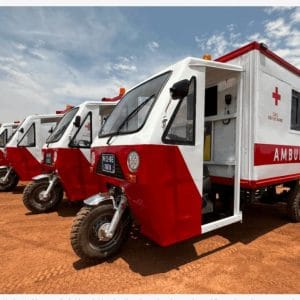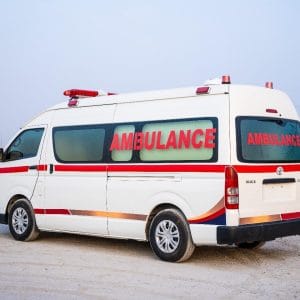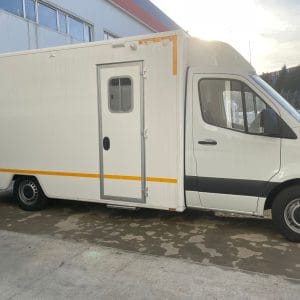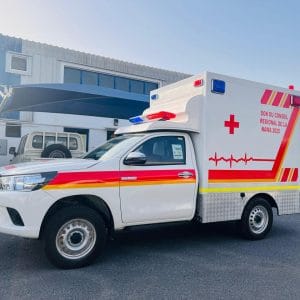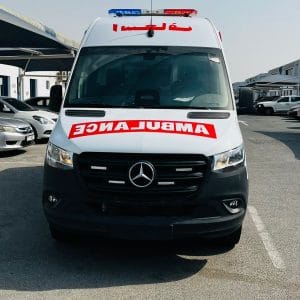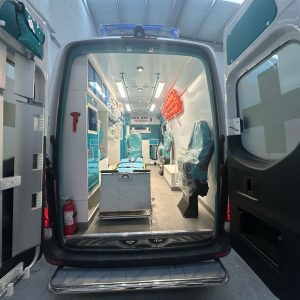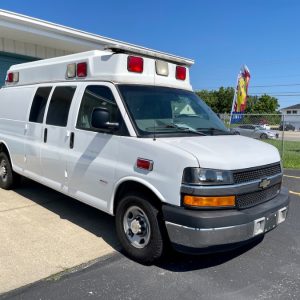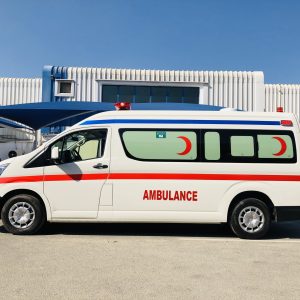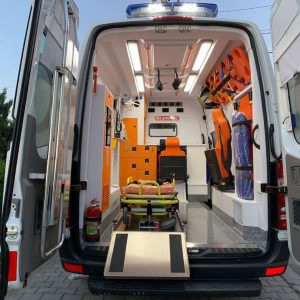1. Introduction
Mobile operating rooms are an innovative solution that has transformed the healthcare sector. This solution has a significant impact on people’s lives and helps healthcare practitioners provide better care. This paper aims to explore the evolution of mobile operating rooms and end with talking about their impacts on healthcare. Further, industry experts have stressed the need to conduct relevant research to understand the various environmental, operational, and functional impacts of M-OR solutions to support decision making effectively.
In the present conditions, when an operating room must be set up in a destroyed, non-existent, or critically affected healthcare facility, it takes a few hours to several months to address this demand. Moreover, it is not always feasible to establish a “permanent” operating room to address such scenarios. Therefore, a rolling up of the operating room, on demand, becomes essential to provide a quick, time-critical surgical response in the event of an emergency. Mobile operating rooms (M-OR) are a potentially effective option in such scenarios. The M-OR conversion setup may involve a few selected items to offer basic surgical services and include some advanced surgical facilities to provide immediate surgical attention. The number of items to be included in M-OR and their tailored configurations need to be defined. In addition, the time required to convert an M-OR from one scenario to another needs to be factored in while organizing the M-OR as part of the strategic surgical services and the everyday healthcare operations. The process of decontaminating the M-OR if required and possible will help in exploring and understanding the usability of the M-OR in specific disaster scenarios.
1.1. Definition and Purpose
A mobile operating room (MOR) or a mobile surgical unit is a set of interconnected spaces that have been converted into a surgical care space to meet the need for services that an existing facility may have difficulty housing or providing. They are intended to be fully functional and as sterile as can be expected considering their transportability. The spaces and their fixtures will be planned to support the level of sophistication required by the surgical or medical demands for the surgical/healthcare procedures to be performed.
Mobile operating rooms can be customized to the level of a standard clinical operating room, a specialty room (cardiovascular and neuro), to a hybrid operating room, or to function as a completely modular specialized space that is designed around a specific type of procedure. They are designed to communicate and support operating room equipment because they hold a patient in situ (in the bed) and the different departments/medical equipment required for patient care. These units and their systems can be equipped with all the comforts and functionality present in a “brick and mortar” special procedure room. This includes special lighting, radiology equipment, communication systems, and operating room equipment.
1.2. Significance of Mobile Operating Rooms
One of the prime reasons why mobile ORs are given priority in healthcare services is the number of benefits they offer. With entire surgical facilities on-the-go, relocatable ORs are considered to be quite advantageous to quickly modify surgical facilities according to the site of work. Urban and rural areas, especially remote ones, are among the most crucial regions to consider mobile ORs, considering the overwhelming number of people that have to travel miles for healthcare services or emergency treatment. Natural disasters, military deployments, and other emergency situations where medical care is required can also extend the accessibility to quality healthcare via mobile ORs. Quite a few countries in the world contain various resource-constrained regions. These regions can have quite a few needs that are specific to operation theatres. These areas may be difficult or may not have enough funds to build the infrastructure required for operation theaters.
Also, some of the surgeries may have to be performed in an emergency, but there may not be time to book and occupy the operation theaters due to the late arrival. To develop and incorporate mobile and relocatable solutions in such a scenario can solve this problem. There are situations when in response to a pandemic, repositories nearby are encouraged to increase their capacity quickly. In such cases, mobile operation theaters can be used to create newly licensed room at the last moment. There are various vectors of recent thoughts and trends that govern the motivating factors behind the operating systems’ need and development.
2. Technological Advancements
For a period of two decades, mobile operating rooms became a widespread and powerful solution for many healthcare organizations. Advancements in technology, specialty upgrades, and feature sets have been the primary drivers in this field. The global trend of advanced EHR analytics and interoperability has transformed the mobile OR and made them less rare, but not inconsequential.
CT machines, fluoroscopic beds, and portable C-arms with low-energy x-ray devices began replacing large generators long before the federal government began regulating mobile imaging. They are also the same ‘most leased’ products today. These pioneering solutions were especially critical to numerous health system cardiovascular endeavors, which is why many mobile operating room companies have feature-rich and specialized enhancements in a variety of offices. Mobile operating room space is a collection of novel, innovative systems that integrate with health system EHRs to coordinate surgical standards, assets, and insights. Some have dedicated cloud servers that receive data from instruments and systems. They have user dashboards for users to arrange, follow, calibrate the personnel schedule, and plan the timetable. Staff members can communicate with one another, as well as send reports, availability, and cause delays. Others have portable C-arm CT scanners that incorporate radiology, EHR, and operating room analytics to reduce exam times, improve disorders, and radiation levels. Some organizations even developed and are refining artificial intelligence models that enable C-arm researchers to provide instant feedback on image quality.
2.1. Key Features of Mobile Operating Rooms
While MOs are similar to their fixed counterparts, they possess several technical components or features that either set them apart or give them additional functionalities. As can be inferred from Table 1, the key difference between MOs and fixed ORs lies in the ways the different component systems or technical features are either combined or work together. The core systems any MO working group or project report in its MO-Friendly-OR concept refers to are:
– Robust infrastructure/4G-LTE, encrypted, HIPAA compliant: even air-gapped network – On-site/cloud storage and streaming – Remote diagnostics – Video walls – Sensors that can monitor temperature and humidity – Surveillance cameras with the ability to record to a server – The ability to remotely control or deploy other technology – Air conditioning/Heating for outside events is desired while internal air handling should meet ASHRAE surgical specific recommendations while having a minimum of 12 air changes per hour – Air curtains for outside events – Connectivity continuity: the mobile OR can run self-sufficiently without access to the hospital network; in case of the node losing its connection to the internal hospital network, the node will still be able to provide surgical services; the connection to the hospital network is necessary when scheduled maintenance of the node is programmed.
2.2. Integration of Telemedicine and Remote Monitoring
Due to their flexibility and relatively low cost in respect to traditional operating facilities, mobile operating rooms are often used as demographic or remote area response. These can be temporary facilities, in the form of transportable tents or trucks containing the necessary equipment and personnel, or flyaway hospitals – the certain components of a hospital operating room transported using military transport aircraft to overcome geographical limitations. The complete set of an operating room transported with aircraft to a disaster site is referred to as a mobile field hospital. The manufacturer cannot estimate the number of surgical operations, nor the surgery time or type, but must supply a range of equipment, possibly self-contained, for an unknown period of time.
Finally, the technology behind mobile operating rooms is an indicator of the development of telecommunications technology as well, most obviously in the case of telemedicine, camera systems, and incorporating telemedicine/remote consultation contributions to a system. Telemedicine in healthcare has been found to be most successful in an integrated approach with remote monitoring. This can assist physicians and surgeons in diagnosing and remotely checking the patient post-surgery, freeing up primary care physicians to spend more time with patients. An ideal application of remote monitoring integrated with a mobile operating room is the follow-up physician appointment, done by video conferencing. Mobile telemedicine solutions have largely revolved around vehicle-based surgery rooms and have not been taken up to a great extent as the next step in healthcare. The new health notion of using technology to reach underserved populations (often in remote areas) for health care is telemedicine. It is an integrated approach allowing medical professionals to meet several goals at the same time. Overall, telemedicine has the aim of eliminating distances and improving healthcare.
3. Benefits and Challenges
Mobile operating rooms (M-ORs) have proven to be an invaluable resource in many cases: emergency medical setups in disaster-struck areas, field/hub hospitals, point of care surgeries, and pop-up events such as donor transplant. They quickly ease the burden on overloaded hospital systems, especially during the COVID-19 pandemic. However, despite the promise that M-ORs hold for supporting healthcare, their prospective benefits and shortcomings have seen little analysis. While these systems can, in some cases, allow access to inaccessible populations, provide virtual education and outreach program community services, and enhance the capacity to hold mass gathering events, they are not currently used as a part of mainstream healthcare provision in the United Kingdom (UK) or Europe.
A parallel has been drawn between M-ORs and a relatively new concept in the UK and Europe: mobile healthcare units that provide medical treatments for lower healthcare costs by “curing people early” and enabling people to manage their own conditions. In this section, we evaluate the potential benefits and challenges of M-OR provision. Where possible, we highlight evidence regarding successful and unsuccessful provision of such operating facilities from past large-scale events.
Benefits: Emergency major outbreaks are one of the important areas most developed, such as US-Desert Shield/Desert Storm, France-Tsunami, Canada-NATO. M-OR provides a portable environment for healthcare service for a few days, 14-30 days for developed countries. The facility, catering, and logistic support obtainable from the army proved successful. Next to the army, international health services NGOs are tapping into the advantage. M-OR established in the premises of a developed hospital reduces patient overload as well as offloads the hospitals. Public health preparedness should shift focus to provide M-OR in a closed-door facility like the premises of a private/corporate hospital where people in need of emergency can be shifted undercover itself. Mobile O.T.s can also be a replacement for planned surgeries in locations where a one-time large congregation will be attending, such as spirituality congregations, cities where music troupes have only come to play, football world cup locations, pop-up events such as music festivals, or a science exhibition, etc., where one-time large medical care is required. The benefit of which will enable any surgeon to carry out the surgeries. In some developed countries, as corporate social responsibility, they are providing these mobile O.T in donating medical camps and deben.
3.1. Advantages of Mobile Operating Rooms
Portable, or mobile, operating theaters offer a number of advantages. Because reducing infections has been and continues to be a major concern inside of inpatient operating rooms, especially ones that focus on implants, being able to isolate cases when it is possible to do so improves outcomes for implant patients. This includes the ability to perform operations in a separate location, if necessary because the hospital is under construction or necessary remodeling. This is a benefit to patient care and increases the ability of the hospital to respond to the needs of the public, their future patients, and the surrounding neighborhood. Undergoing a full-scale construction project is difficult for most hospitals, so it is likely that construction procedures will move towards fully modular systems in the future. In the early stages of construction, a hospital could work with a mobile OR vendor to rent a unit and position it into the location that the permanent inpatient operating room will be in. As the project goes on, the unit can be moved into another desirable location.
Portable operating rooms can be put in affordable rental equipment fleets. Aside from cases that want or need to be kept isolated, it is difficult for health systems to plan for cases in a mobile operating room when they also have access to permanent inpatient operating rooms. But for low-use hospitals, purchasing a mobile OR can make economic sense if they can fill it up with one to five scheduled cases per day, in order to justify the full-time salaries and wages associated with at least a part-time surgical team. There are a number of new or existing trends in healthcare that could justify the use of a mobile operating room that are discussed elsewhere in this paper, but for a hospital already operating, the new or increasing benefit of a mobile OR is that in disruptive times, a mobile OR can be utilized by its owner and likely at a higher utilization rate than would be expected during normal times.
3.2. Challenges and Limitations
To the best of the authors’ knowledge, large-scale surgical trials comparing surgeries conducted in operating rooms (ORs) to those in mobile ORs have not been performed. It should therefore be noted that the idea of developing such a dedicated OR may be challenged on the basis of lack of evidence. To sweeten this critical viewpoint, it should be considered that developing a mobile OR may also lead to accessibility of an ideal environment for surgical operations in the circumstances of post-war trauma and emergency or in natural disasters. Given the fact that such a dedicated environment has already been used for surgeries in heart hospitals, there is still much to be learned from the methods utilized by these facilities. The social aspect of providing an environment of comfort for the surgical team and the patient together with little distractions from external factors should be carefully investigated in further studies. Therefore, more research is needed to validate the results of a new type of OR specially designed for bone fractures. Some other factors must be considered when treating particularly these cases: the hospital environment is not that good (hospitals in most cities are practically obsolete); the psychological status of the staff and the patients seems to be very low; the required money is not available. Technology dependence is one of the main limitations inherent in mobile units resulting from their sophistication and cannot be considered as a major disadvantage or limitation. Nevertheless, the need for high-standard human resources who are well familiar with the operations of mobile units should be highlighted. Several studies have documented that such dependence is outdated. Given the considerable advantages offered by mobile operating rooms, nothing should put people off from establishing and investing in using them properly.
The designed system is perfectly specialized for intervening in case of a public disaster. In some cases such as natural disasters, mobile operating rooms are supposed to be used rapidly by transporting them by air or road to a destination far away from their main hospital base. The main limitation in current mobile operating rooms is that they perform the operating room without access to especially high-tech equipment such as the MRI or CT scanner operating room. Together with this limitation, electronic devices cannot necessarily have the long lifetime battery needed to save and transmit the ECG and blood pressure signal. One of the other drawbacks could raise the question: whether moving the patient scheduled for an elective operation to a remote mobile operating room, preferring the high-tech operating room equipped with a CT scanner as the final destination of surgery, could be more troublesome, time- and cost-demanding for a team of a trained physician who were supposed to relocate a patient to an existing high-tech operating room surgical suit and who are knowledgeable about any type of surgery? On the other hand, recommendations are given to create a well-trained multi-serviced medical team in the case of natural or public disasters both for immediate and emergency surgeries.
4. Case Studies
The material discussed so far has centered more on the potential and promises that mobile operating rooms have. Therefore, it may further illuminate the possibilities of mobile technology to look at how cases within the existing scholarship draw from these promises. The following case studies represent these real-world applications and outcomes as outlined within the discussed frameworks.
Tanzania: Mobile operating rooms can support an array of procedures, including a range of surgery and diagnostic interventions as shown by their use in the context of health screening at Pride Africa. Procedures undertaken within mobile facilities in other sectors have included dentistry in the United States, Nepal, Tanzania, and the United Kingdom, operating under the banner of mobile dentistry.
The mobile ophthalmology clinic, part of the Variety Club of Great Britain, held a 3-day mobile clinic in the grounds of the RVI in the Spring of 2009. Four sessions were held each day, and 25 children were treated each day, a total of 100 children. A maximum of 8 children were looked at per session, and potential attendees had received an earlier invitation for an appointment time. Transport to and from the clinic was looked after by staff at the hospital, and the day was facilitated by them with suggestions as to the way we could be of maximum help. The children were preselected by the pediatricians and started with an introductory photograph followed by a short consult with the ophthalmologist. A diagnosis was made, and a preference for size, type, and color were decided ready for the selection of eyewear.
Vietnam: As described above, the Vietnamese-German malaria project uses mobile intervention teams to diagnose and treat malaria in remote and hard-to-reach areas in the Kon Tum province. The team deploys a ‘large, re-locatable tent’ as a clinic and utilizes the same space as their living quarters when they operate in the field.
4.1. Successful Implementations in Various Healthcare Settings
4.1. Successful Implementations in Various Healthcare Settings. Case studies and success stories are difficult to capture due to technological innovations and their success creating significant demand. Varying healthcare settings have had successful implementations of MOTs. Some hospitals have implemented MOTs to expand OREs to relocate a brief distance away, joining advancements in moving ERs to create space. Still, other scenarios can save time during construction by providing more downtime for researchers. Options created by MOTs have helped attract more workers to cities. New rural facilities are being proposed to help recruit and train staff immediately by combining MOTs with office-based organizational features. Military and government agencies have also invested in MOTs, resulting in stronger, smarter, and more effective U.S. forces.
An MOT is being used to moor a lithium mine in eastern Manitoba, close to the Ontario border, near the Matheson Island mine which is located in the heart of Lake Winnipeg. In this remote and isolated mine, Cote Gold hoped to build and use a research facility where lithium could be tested and processed 280 miles south of the ore body’s kingdom in Thorne, Ontario. There the money would be used for construction and infrastructure rather than decommissioning to build on an island site. Whether COVID-19 will exacerbate the labor shortage in northern Manitoba is not yet known. Côte hopes that at the peak of construction, when there could be hundreds of workers, the project will contribute to provincial policies related to the pandemic. It will respond to other inquiries in collaboration with the administration and the Office of Public Health. In 2022, Cote Gold plans to break ground on a 28,000-square-meter lithium water plant and a 5,000-square-meter ferrous ore processing plant on an MOT.
4.2. Lessons Learned and Best Practices
Case studies of the NFORS- and MSF-run portable field hospitals and of the Cuban mobile OR teams highlight the advantages and disadvantages of using mobile ORs for humanitarian response but do not offer a mechanism to measure either clinical effectiveness, cost-effectiveness, or patient-centered outcomes after a sudden-onset disaster using mobile ORs. This section attempts to develop lessons learned and best practices from the three case studies and the field expert opinions stated at the Delphi Process. All three of these groups have deployed mobile operating rooms in humanitarian response. Honeycutt and Rohoper (2009) stated the need for best practice guidelines for field hospitals. This paper will further develop these concepts based on the additional case studies, literature review, and Delphi process that informs the remainder of this work.
Lessons from this review of case studies emphasize four main points. First, personnel training and adequate support services enable effective mobile ORs. Second, specialization is necessary both to meet the short-term demand and to minimize the space and money lost keeping surgical teams without patients. Third, cash for work is crucial in areas of food insecurity. Finally, owning surgical equipment that can convert from static to mobile use is imperative. The costs and benefits of using a mobile OR team should be further studied to combine mobility and expediency with cost-effectiveness. Furthermore, if MSF is unable to maintain high surgical rates during an epidemic of infectious disease even after introducing aggressive early surgery, intensive screening, and specialized decontamination, other best practices in the management of infectious disease need to be reassessed.
5. Future Trends and Innovations
Future Trends & Innovations
Given the growing trend of utilizing mobile operating rooms in diverse situations, experts are poised to expand and further develop this unique and flexible resource. As the healthcare field continues to embrace the many uses of the mobile operating room—disaster recovery, flexible electives, compression of surgical case times or addressing service line goals, growth strategies and cost-effective solutions for facilities unable to invest in new construction or major renovation—several future trends and innovations are on the horizon.
Pop-Up Surgery Centers: Very high-end mobile operating room trailers are the future for pop-up surgery centers in areas where towers cannot be built.
Specialty Medical Office Buildings (MOB) with Infrastructures for OR Pods Development: Urban MOBs building out large floor plans with a service line, for example, for total joints. The site may also have a floor or two of space for training and education, health, primary care, urgent care, home health, infusion, therapy, imaging, diagnostics and express testing. The idea is that the entire joint experience would take place in one location; the patient could select a private hotel-like room, a semi-private room with a guest bed or a double room. Hotel-like rooms offer special services such as a playroom, pet amenities and/or massage five miles from the hospital campus. Given the price and competition, it does not make an economic development sense for these centers to build out ORs, but they could have infrastructure to run a flexible solutions OR pod as needed for surge populations.



